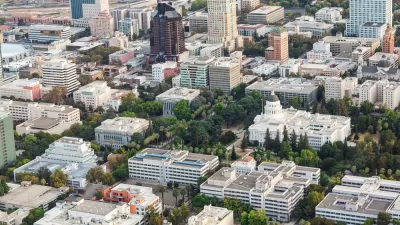The following came through on a planning list serve, and I thought it raised several very provocative points that speak to the core of how we plan in the U.S. “I heard, though I cannot remember the source, of a municipality that countered predictable neighborhood opposition to a higher density TOD proposal by broadening the review process to the whole community. I believe that the actual adjacent property owners were deemed to have a conflict of interest: i.e. their backyard versus overall better transit and housing opportunities for the entire town.
The following came through on a planning list serve, and I thought it raised several very provocative points that speak to the core of how we plan in the U.S.
"I heard, though I cannot remember the source, of a municipality that countered predictable neighborhood opposition to a higher density TOD proposal by broadening the review process to the whole community. I believe that the actual adjacent property owners were deemed to have a conflict of interest: i.e. their backyard versus overall better transit and housing opportunities for the entire town. Can anyone direct me to such rational planning examples?"
I haven't verified whether this characterization is correct (although answer was Perth, Australia), but it struck me that the perspective implicit in this observation is a bit odd.
I'm not a fan of NIMBY's. In fact, I believe that NIMBY's are one of the biggest impediments to housing and transportation innovation, including allowing more density and mixed use. I think one of the fundamental challenges to modern planning is distinguishing between legitimate concerns about development and simple, reactionary hostility to anything that might upset the status quo. I've written about a market-based approach in the Journal of Urban Planning and Development (December 2005 issue), but I won't go into the detail here.
Rather, I want to challenge implicit notion that someone who is impacted by a development proposal somehow has a "conflict of interest" in the debate over the proposed project. Moreover, the idea that somehow broadening the approval process to expand the influence of individuals and interest groups that will not shoulder the burden of a proposed development is a recipe for planning disaster.
I'm drawing primarily on my experience as a member and former chair of planning board. I saw NIMBY activity first hand. But, I also found that opposition in and of itself was not reactionary NIMBYism. Citizens raised critical issues and points that should have demanded our attention on the planning board, but would likely not have been discussed if they weren't part of the process. Key issues included concerns about the location and intensity of changing traffic patterns, storm water runoff, and drainage. Other issues were raised as well (e.g., effects on community character, market potential, impacts on public service levels). Some we could address and others we could not. And of course, some were simple and pure objections to change.
The task for the planning board is to distinguish between those concerns that are legitimate and tangible enough we can address and are within the scope of our planning board's authority. The role of the planning board chair and planning staff is to guide the members of the planning board and city council through this process to ensure that community benefits are maximized and external costs minimized. Expanding the planning process to include groups with no tangible stake in the consequences of a negative outcome dilutes this critical function of the planning process.
Moreover, I've found that NIMBYs also work on the city and regional level. Aggressive environmental activists bog down the planning process in many ways, including presenting "evidence" against development projects that is only vaguely connected to the real outcomes of the project. Non-local open-space advocates have also lobbied hard against development projects even when the design was infinitely better and more integrated into the urban fabric of a community than the overlay zoning, which was the developers default alternative.
On the whole, my experience has been that people (and businesses) directly effected by a proposed development raise the most important and substantive issues in evaluating a development proposal. They also bring the most intimate knowledge of the potential impacts. It's our job as a planning board to make the decision based on the impacts on neighbors and the community.
Of course, imbedded in the planner's comment above is the self-evident belief that high density, TOD developments are good for the community. They are not if they emerge in the wrong place at the wrong time and under the wrong circumstances. My first project as a graduate student involved rewriting a comprehensive plan for a small suburban community that was figuratively and literally ripped apart when a medium density low income housing development was dropped into it in the mid-1970s. The community went from nearly 80 percent homeowners (and stable) to majority renter and transient. The community's size increased by a third, the physical landscape was fundamentally altered, crime went up, property values plummeted. The community never recovered. In my view the ends (high density, TOD) do not justify the means (further politicizing an already highly politicized planning process).
In another future post, I'll lay out what I think are the building blocks for an effective process to distinguish between concerns we can address on the planning board level and those we cannot. But, for now, I'm interested in hearing the reactions from those that read this post.

Maui's Vacation Rental Debate Turns Ugly
Verbal attacks, misinformation campaigns and fistfights plague a high-stakes debate to convert thousands of vacation rentals into long-term housing.

Planetizen Federal Action Tracker
A weekly monitor of how Trump’s orders and actions are impacting planners and planning in America.

In Urban Planning, AI Prompting Could be the New Design Thinking
Creativity has long been key to great urban design. What if we see AI as our new creative partner?

King County Supportive Housing Program Offers Hope for Unhoused Residents
The county is taking a ‘Housing First’ approach that prioritizes getting people into housing, then offering wraparound supportive services.

Researchers Use AI to Get Clearer Picture of US Housing
Analysts are using artificial intelligence to supercharge their research by allowing them to comb through data faster. Though these AI tools can be error prone, they save time and housing researchers are optimistic about the future.

Making Shared Micromobility More Inclusive
Cities and shared mobility system operators can do more to include people with disabilities in planning and operations, per a new report.
Urban Design for Planners 1: Software Tools
This six-course series explores essential urban design concepts using open source software and equips planners with the tools they need to participate fully in the urban design process.
Planning for Universal Design
Learn the tools for implementing Universal Design in planning regulations.
planning NEXT
Appalachian Highlands Housing Partners
Mpact (founded as Rail~Volution)
City of Camden Redevelopment Agency
City of Astoria
City of Portland
City of Laramie





























